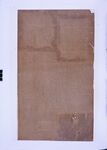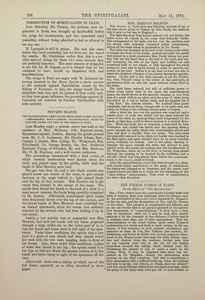< The Oldest Medical Work in the World (continued from page 3-9) >
religion and of priesthood, and of medicine. On the last mentioned subject, six books are known to have existed. Though many scrolls have been found treating on all of the above topics, the Hermetic writings have remained undiscovered; and hence their very existence has repeatedly been denied, and the tradition considered as one of the many curious myths which overhang the ancient history of mysterious Egypt.
During the winter of 1872-3, Ebers, the German archaeologist, while residing in the vicinity of Thebes, learned from an Arab of the existence of a papyrus scroll, found between the bones of a mummy, some fourteen years previously, by a person since dead. By dint of a large offer, Ebers obtained the scroll ftom the Arab. It consisted of a single sheet of yellow brown papyrus, of the finest quality, over sixty feet in length and about eleven inches broad. The writing was clearly executed in red and black inks; the paper was in perfect condition; and the entire work was in a state of remarkable preservation. Hurrying to Leipsic, Ebers at once began the deciphering of his treasure; and the results of his studies are now given to the world, with the announcement that the work is, beyond question, one of the long-lost six Hermetic books of medicine.
The age of the manuscript was determined by the study of the forms of the characters, by a calendar which is found in the book, and by the occurrence of the names of kings, all of which show the period of writing to be the year 1552 B. C., at which time, it is interesting to note, Moses was just 21 years old. A translation of the script also confirms the origin of the work, since (as was the custom of the Egyptians, in order to give greater authority to their writings) it is ascribed to the god Thoth or Thuti, who, as we have already mentioned, was the first Hermes.
By the aid of chromo-lithography, a facsimile of the papyrus has been prepared; and it is now published, together with notes, by Ebers, and a translation of some portions. A copy of this rare and important work has lately been received at the Astor Library, in this city; and from one of its pages we have obtained the drawing from which the annexed engraving is made. The characters are facsimiles except in point of color, those which are lightly shaded being written in red, and therefore of course impossible for us to reproduce. The script is of the hieratic form, which was one of the four distinct graphic systems used by the Egyptians. It was devised as a shorter method of inscribing the hieroglyphics, and bore about the same relation to those symbols as our written letters do to printed characters. In this form the great body of Egyptian literature has reached us; and in order to translate it, it is first necessary to resolve the hieratic contractions into their corresponding hieroglyphics. This is done in the second engraving; and the reader will find it interesting to compare the lines of the hieratic writing with the hieroglyphics, and note the similarity. The hieratic reads from right to left, the hieroglyphic from left to right; so that the lines end at the point, A. Notice the similarity of form between the characters at B, also the ideographic nature of the hieroglyphic, the words “to pour out” being symbolized by a man in the act of throwing objects from one hand into another. Notice also the symbols at C, indicating four days. A portion of the character Is similar to that used to mean the sun or god Ra, and the four down strokes indicate the number of suns or days. Another ideographic symbol is the bee, to indicate honey. The mode of writing the weights is also curious. The tenat or unit of volume was about six tenths of a quart, and the drachme is probably the same as the Arabic dirhem, and is equivalent to 48 English grains. The first page of the scroll opens thus: “The book begins with the preparation of the medicines for all portions of the body of a patient. I came from Heliopolis, with the Great Ones from Het-aat, the Lords of Protection, the Masters of Eternity and Salvation.”
The preface continues somewhat in the same strain through the page. On the second leaf is found the extract given above, introduced by a kind of charm, which the physician is to bear in mind while administering the doses. The following translation is literal:
“Chapter treating of the taking of medicine. The medicines approach. The expulsion of everything is accomplished from my heart, from my limbs. Powerful are the channs. On the medicines. Beginning: I think of the time when Horus and Set were conducted to the great Hall of Heliopolis, so that counsel might be taken on the Hodes of Set and Horus. * * Words which are spoken on the taking of medicines in their regular order, and frequently.” Then follow the extracts above, and some more recipes of which the following are specimens: “Caraway seed, 1/64 drachme; goose fat, 1/8 drachme; milk, 1 tenat. For sick bowels, the same: Pomegranate seed, 1/8 drachme; sycamore fruit, 1/8 drachme; beer, 1 tenat.”
Ebers translates but two pages literally, and gives a synopsis of the balance of the book. The chapter headings are peculiar. The initial chapter consists mainly of recipes and the preparation of medicine; then follow chapters on salves for removing the uhan; catalogue of the various uses of the tequem tree; medicines for alleviating the accumulation of urine and diseases of the abdomen; “the book of the eyes;” medicaments for preventing the hair turning gray, and for the treatment of the hair; on forcing the growth of the hair; salves for strengthening the nerves, and medicines for healing the nerves; medicine for curing diseases of the tongue; medicines for the removal of lice and fleas; medicines for ears hard of hearing; “the secret book of the physician;” “the science of the beating of the heart;” and “the knowledge of the heart, as taught by the priestly physician Nebseeht.”
The difficulties in the path of the translator in the shape of technicalities are of course very great; and probably for this reason, he reserves the complete translation of the book for future publication, when it will be issued with notes, etc., obtained by further study. One extract is given, however, to show the general style of directions to the physician. It reads as follows;
“Rules for the re-het, that is, suffering in the pit of the stomach. (Pylorus or cardia). When thou findest anybody with a hardening of his re-het, and when eating he feels a pressure in his bowels (chet), his stomach (het) is swollen, and he feels ill while walking like one who is suffering with heat in the back, tau nu peht, then look at him when he is lying outstretched, and if thou findest his bowels hot and a hardening in his re-het, then say to thyself: This is a liver complaint, sepu pu n merest. Then make thyself a remedy according to the secrets in botanical knowledge from the plant pa chestet and from scraps of dates. Mix it and putit in water. The patient may drink it on four mornings to purge his body. If after that thou findest both sides of his bowels (chet), namely, the right one hot and the left one cool, then say of it: That is bile. Look at him again, and if you find his bowels entirely cold, then say to thyself: His liver (?) merest is cleansed and purified: he has taken the medicine sep sef sep, the medicine has taken effect,”
In view of the direction to look at the patient " when lying outstretched," it is curious to note that (according to Dunglison) the priestly physicians of Egypt are said by Diodorus to have formed their diagnosis principally on the position which the patient assumed in bed.
The book is one of the most valuable contributions to our knowledge of the arts of the ancient Egyptians that has ever been discovered; and the clear manner in which it is written, and its freedom from the nonsense or gibberish usually accompanying so-called charms, serve still further to enhance its archaeological importance. It will elicit the deepest interest in every civilized country, and will, we trust, give new life to the science of Egyptology, from the study of which, and from the revelations which yet may be expected from the ancient tombs of Egypt, it may be hoped that a clew will be found to the rediscovery of those arts which died with the wonderful people who practised them.
The Firman Fiasco in Paris
Sir, — Your readers have the opportunity afforded them this week of forming their own judgment about the Firman case, by the publication of the proces verbal signed at Dr. Huguet’s, on the one side, and the declarations of Mrs. and Mr. Firman on the other. The question is complicated and difficult, and no one can wonder that to all persons ignorant of the marvellous phenomena of “materialisation” it must seem a clear case of imposture. And yet it may be, and, after careful analysis of all the elements of the evidence, I believe that it is, nothing more than one of false appearances. That the materialisation of the dwarf Indian spirit under Firman’s mediumship is a reality and truth is made certain by the testimony of four witnesses of such superior intelligence and character as Mme. de Veh, Mrs. Watkins (her mother), Mr. Gledstanes, and Count de Bullet, who on four occasions subsequent to the Huguet scene have seen the little Indian, separate and distinct from the medium, having seen him on one occasion even rise in the air till his feather head-dress touched the ceiling, which elicited from Mr. Gledstanes the request to him to make a mark on the <... continues on page 3-11 >
Editor's notes
- ↑ The Firman Fiasco in Paris by Firman, E. M.; Firman A., London Spiritualist, No. 142, May 14, 1875, pp. 234-5
Sources
-
London Spiritualist, No. 142, May 14, 1875, pp. 234-5


